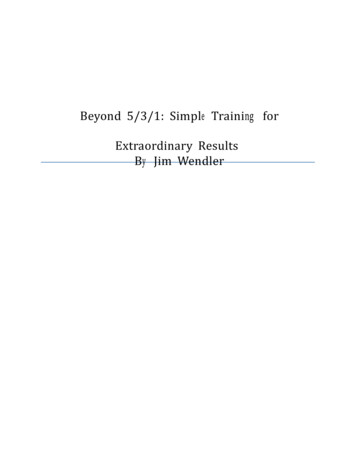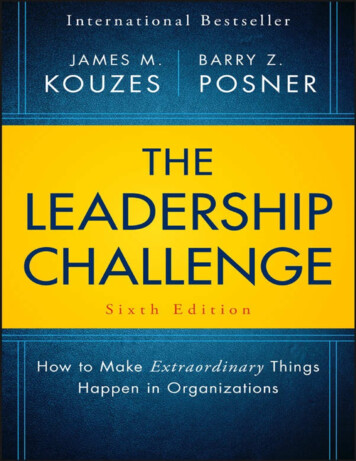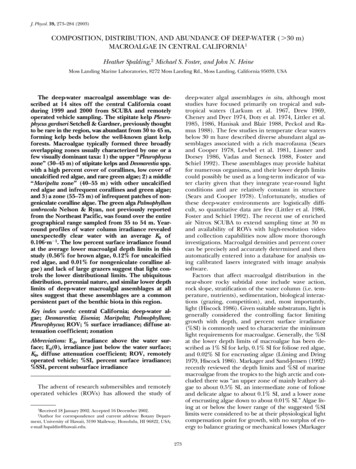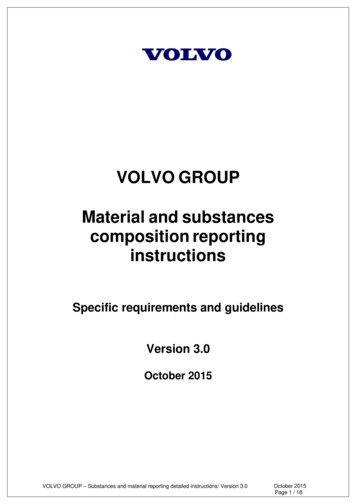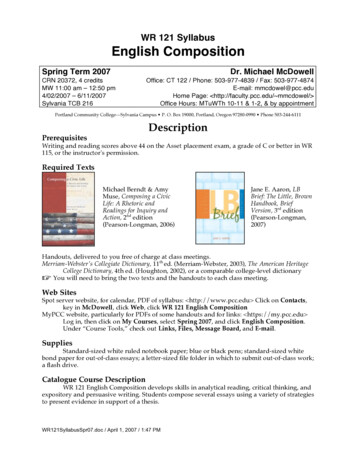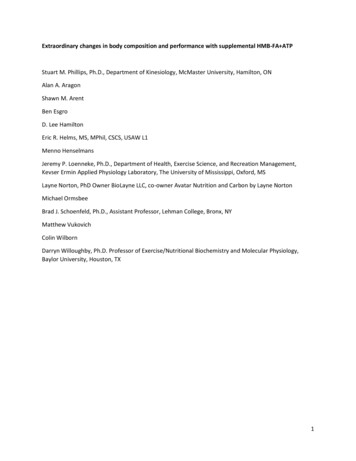
Transcription
Extraordinary changes in body composition and performance with supplemental HMB-FA ATPStuart M. Phillips, Ph.D., Department of Kinesiology, McMaster University, Hamilton, ONAlan A. AragonShawn M. ArentBen EsgroD. Lee HamiltonEric R. Helms, MS, MPhil, CSCS, USAW L1Menno HenselmansJeremy P. Loenneke, Ph.D., Department of Health, Exercise Science, and Recreation Management,Kevser Ermin Applied Physiology Laboratory, The University of Mississippi, Oxford, MSLayne Norton, PhD Owner BioLayne LLC, co-owner Avatar Nutrition and Carbon by Layne NortonMichael OrmsbeeBrad J. Schoenfeld, Ph.D., Assistant Professor, Lehman College, Bronx, NYMatthew VukovichColin WilbornDarryn Willoughby, Ph.D. Professor of Exercise/Nutritional Biochemistry and Molecular Physiology,Baylor University, Houston, TX1
The authors of this letter read with deep skepticism the recent report from Lowery et al. (9), employinga supplement that provided 3g of beta-hydroxy-beta-methyl butyrate as a free acid (HMB-FA; threedoses of 1g each) plus 400mg of oral adenosine triphosphate (ATP) in young men who resistance-trainedfor 12wk.These authors (9) report gains in lean mass and performance that are greater than thosereported in a similarly astonishing earlier study from Wilson et al. (16). Our skepticism of the resultsreported by Lowery et al. (9) exists on several levels. However, our collective disbelief of these data restson the collective experience of the authors of this letter, who have conducted more than 60 resistancetraining studies,who have never observed gains in lean body mass that are of a similar incrediblyuniform magnitude as those reported by Lowery et al. (9). As opposed to the often-observedheterogeneity in resistance training-induced hypertrophy, Lowery et al. (9)must have observedremarkably consistent between-group changes in muscle mass to find statistical significance betweenthe supplemented and placebo groups. This is remarkable in that this was seen in a total of 17 subjects(n 9 placebo, n 8 HMB-FA ATP). We are particularly skeptical that the ‘divergence’ between the HMBFA ATP versus placebo groups occurred in the face of what the authors refer to as an optimal trainingparadigm, with optimal nutrition, and the advice of an experienced dietitian. Would the authors bewilling to share subjects’ individual data? We ask since the mean gain in lean body mass in thesupplemented group was 8.5kg (9), meaning there were some subjects who gained more and uniformlyso for the treatments (in only 17 subjects, however, they were divided between groups) to be sorobustly different? This is also an astounding gain when one considers that the subjects were previouslyresistance-trained and so would have had less propensity to gain lean body mass(10),We could not findthe absolute values for the beginning and final values for body composition and so readers would haveto make assumptions (since the reported data were incomplete) as to how much body compositionchanged. Would the authors be willing to present these data?We are aware of a previous letter from Hyde et al. (6) in which these authors asked for clarification fromLowery et al. (9) on their methods. Thus, our skepticism is clearly shared by others and, given thenumber and research experience of the authors on this letter, quite widespread. In their reply to thisletter(6) Lowery et al. (9) went to great lengths to compare their rates of hypertrophy with thoseprevious reported by other studies. Importantly, however, a number of studies discussed by Lowery etal.(9) as having comparable ‘rates’ of hypertrophy were markedly (5wk) shorter than their 12wkintervention(12). Thus, while ‘rates of hypertrophy’ (assessed with different methods and in differentlabs(3, 8, 12, 14), in different study populations, being overfed and not exercising (3), with differentdietary backgrounds (3, 8, 12, 14), consuming different supplements (8, 12, 14), may have been similar(or greater) to those seen by Lowery et al. (9)the total accrued (over 12wk) fat- and bone-free (i.e.,‘lean’) mass cannot be assumed to be linear, nor equivalent to that seen in their study. Further, what isrevealing is the astonishing performance differences reported by Lowery et al. (9), which implies notonly greater total lean mass gains but extraordinary functionality to the accrued lean mass or by someother unexplained mechanism. That is, why did HMB-FA ATP impart an astonishing ‘functionaloverreaching’ response with the optimal training paradigm, with great dietary support, and in highlytrained and motivated subjects and not in the placebo group?It is important to understand the limitations of dual-energy x-ray absorptiometry (DXA), which derivesby difference at- and bone-free mass, which is a variable that is not equivalent to muscle (5, 11). Thelimitations of DXA and ultrasound, the two muscle-based outcome measures have been clearly outlinedin a recent review (5). For DXA: “Cannot specifically discern skeletal muscle mass[bold and italics2
added] and quality as can CT [computerized tomography] and MRI *magnetic resonance imaging ”(5).For ultrasound: “Technical skill required. Excess transducer pressure and orientation can influencemuscle size measurements. Identification of reproducible measurement sites critical. Care needed tomake muscle is in relaxed state. Conditions such as proximity to exercise bout, hydration, are importantto control” (5). Lowery et al. (9) report nothing with respect to the ultrasound machine used, thehydration status of their subjects, or proximity to an exercise. It would be useful for readers if Lowery etal. (9)could let the readers know the training level of the researcher(s) who conducted the ultrasoundtests, noted whether more than one researcher carried out testing, whether these testers were blindedto the group assignment while completing/analyzing the thickness measures, and clarify the temporalaspects of testing to determine if there may be any associated confounding issues.In the response to Hyde et al(6) the authors’ purport to have selected “ a responsive population whopossess a quantity of lean mass indicative of previous responses to resistance training .”Notwithstanding the scientific inaccuracy of this statement, the authors must have gone through ascreening process of sorts to recruit 17 subjects with lean mass “ an order of magnitude [we note thatan order of magnitude is defined as 10-times greater so this cannot be the case] higher than averagelean mass typically seen in recreationally trained subjects ” Could the authors please state what theexact criteria for inclusion as a subject in this study were? Can the authors please detail the screeningprocess describing how many subjects were recruited and screened to reach this number of subjectsmeeting these criteria? Please also clarify if the subjects were randomised to treatment and placebogroups or pair matched.The only supplement for which we have data showing a mechanistic underpinning for the activity ofHMB is for the calcium salt form (13) and we are unaware of any similar proof-of-principle mechanisticdata for the free acid form of HMB. In the only human study to show any plausible effect of HMB onhuman muscle protein turnover (13), we note that leucine had the same anabolic effects. We also notethat dietary protein can exert a positive effect on gains in muscle mass with resistance training (1). Thus,it is surprising that, given the expert dietary advice and total protein intake of the subjects studied byLowery et al. (9) that the differences in lean mass between the HMB-FA ATP and placebo groups are asimpressive as they are and are ascribed to an, as yet mechanistically unproven, form of HMB and/orATP. As an ingredient of the supplement used by Lowery et al (9), ATP would appear to be, given itsextraordinarily low bioavailability (2)to be useless. However, we note that Wilson et al. (15), using thesame study protocol as employed by Lowery et al. (9), reported that ATP (400mg/d) resulted in apositive effect on muscle mass, strength, and power gains. This is improbable given that oral ATP evenup to doses of 5000mg/d [more than an order of magnitude greater than the dose used by Lowery etal.(9)]for 4wk leads only to increases in circulating uric acid with no detectable changes in ATP in theblood(2). Thus, as opposed to an ostensible increase in post-exercise blood flow induced by the ATP (7)in HMB-FA ATP supplement, the magnitude of which we view as physiologically inconsequential, wefind it biologically implausible that 400mg/d of oral ATP would exert any effect on processes leading toenhanced performance let alone hypertrophy.Many of the authors of this letter have seen either or both Mr. Lowery and/or Dr. Wilson speak atvarious conferences on the topic of HMB. In addition, even a casual perusal of available social mediasites reveals that Dr. Wilson has spoken on the topic of HMB. Thus, we ask, in accordance with allreasonable guidelines regarding full disclosure of potential conflicts of interest now in place at manyjournals (including the Journal of Strength and Conditioning Research - http://journals.lww.com/nsca3
jscr/Pages/InstructionsforAuthors.aspx - accessed Oct 1, 2016)that Dr. Wilson and Mr. Lowery disclosewhether they have ever received travel expenses, stipends, or honoraria, or shares associated with theirwork companies involved with ATP and/or HMB and/or whether they or their spouses have any publicor private interests with Metabolic Technologies, Inc. and/or companies selling or dealing in oral ATPsupplements or their affiliates? This is not an accusation and we fully accept that neither Dr. Wilson norMr. Lowery may have ever received such support, but believe this is an honest and reasonable questionto ask on both scientific and ethical grounds (4)and it is standard practice to make such disclosures.Reference List1. Cermak NM, Res PT, de Groot LC, Saris WH and van Loon LJ. Protein supplementation augmentsthe adaptive response of skeletal muscle to resistance-type exercise training: a meta-analysis. AmJ Clin Nutr 96: 1454-1464, 2012.2. Coolen EJ, Arts IC, Bekers O, Vervaet C, Bast A and Dagnelie PC. Oral bioavailability of ATP afterprolonged administration. Br J Nutr 105: 357-366, 2011.3. Forbes GB, Brown MR, Welle SL and Lipinski BA. Deliberate overfeeding in women and men:energy cost and composition of the weight gain. Br J Nutr 56: 1-9, 1986.4. Gorman DM. Can We Trust Positive Findings of Intervention Research? The Role of Conflict ofInterest. Prev Sci 2016.5. Heymsfield SB, Gonzalez MC, Lu J, Jia G and Zheng J. Skeletal muscle mass and quality: evolutionof modern measurement concepts in the context of sarcopenia. Proc Nutr Soc 74: 355-366, 2015.6. Hyde PN, Kendall KL and LaFountain RA. Interaction of beta-hydroxy-betmethylbutyrate free acidand adenosine triphosphate on muscle mass, strength, and power, in resistance trianedinvidividuals. J Strength Cond Res 30: e10-e14, 2016.7. Jager R, Roberts MD, Lowery RP, Joy JM, Cruthirds CL, Lockwood CM, Rathmacher JA, Purpura Mand Wilson JM. Oral adenosine-5'-triphosphate (ATP) administration increases blood flowfollowing exercise in animals and humans. J Int Soc Sports Nutr 11: 28, 2014.8. Jowko E, Ostaszewski P, Jank M, Sacharuk J, Zieniewicz A, Wilczak J and Nissen S. Creatine andbeta-hydroxy-beta-methylbutyrate (HMB) additively increase lean body mass and muscle strengthduring a weight-training program. Nutrition 17: 558-566, 2001.9. Lowery RP, Joy JM, Rathmacher JA, Baier SM, Fuller JC, Jr., Shelley MC, Jager R, Purpura M,Wilson SM and Wilson JM. Interaction of Beta-Hydroxy-Beta-Methylbutyrate Free Acid andAdenosine Triphosphate on Muscle Mass, Strength, and Power in Resistance Trained Individuals. JStrength Cond Res 30: 1843-1854, 2016.10. Morton RW, Oikawa SY, Wavell CG, Mazara N, McGlory C, Quadrilatero J, Baechler BL, Baker SKand Phillips SM. Neither load nor systemic hormones determine resistance training-mediatedhypertrophy or strength gains in resistance-trained young men. J Appl Physiol (1985) 121: 129138, 2016.11. Prado CM and Heymsfield SB. Lean tissue imaging: a new era for nutritional assessment andintervention. JPEN J Parenter Enteral Nutr 38: 940-953, 2014.12. Stone MH, Sanborn K, Smith LL, O'Bryant HS, Hoke T, Utter AC, Johnson RL, Boros R, Hruby J,Pierce KC, Stone ME and Garner B. Effects of in-season (5 weeks) creatine and pyruvatesupplementation on anaerobic performance and body composition in American football players.Int J Sport Nutr 9: 146-165, 1999.4
13. Wilkinson DJ, Hossain T, Hill DS, Phillips BE, Crossland H, Williams J, Loughna P, ChurchwardVenne TA, Breen L, Phillips SM, Etheridge T, Rathmacher JA, Smith K, Szewczyk NJ and AthertonPJ. Effects of leucine and its metabolite beta-hydroxy-beta-methylbutyrate on human skeletalmuscle protein metabolism. J Physiol 591: 2911-2923, 2013.14. Willoughby DS, Stout JR and Wilborn CD. Effects of resistance training and protein plus aminoacid supplementation on muscle anabolism, mass, and strength. Amino Acids 32: 467-477, 2007.15. Wilson JM, Joy JM, Lowery RP, Roberts MD, Lockwood CM, Manninen AH, Fuller JC, De SouzaEO, Baier SM, Wilson SM and Rathmacher JA. Effects of oral adenosine-5'-triphosphatesupplementation on athletic performance, skeletal muscle hypertrophy and recovery inresistance-trained men. Nutr Metab (Lond) 10: 57, 2013.16. Wilson JM, Lowery RP, Joy JM, Andersen JC, Wilson SM, Stout JR, Duncan N, Fuller JC, Baier SM,Naimo MA and Rathmacher J. The effects of 12 weeks of beta-hydroxy-beta-methylbutyrate freeacid supplementation on muscle mass, strength, and power in resistance-trained individuals: arandomized, double-blind, placebo-controlled study. Eur J Appl Physiol 114: 1217-1227, 2014.5
Layne Norton, PhD Owner BioLayne LLC, co-owner Avatar Nutrition and Carbon by Layne Norton Michael Ormsbee Brad J. Schoenfeld, Ph.D., Assistant Professor, Lehman College, Bronx, NY Matthew Vukovich Colin Wilborn Darryn Willoughby, Ph.D. Professor of Exercise/Nutritional Biochemistry and Molecular Physiology, Baylor University, Houston, TX . 2 The authors of this letter read with deep .


